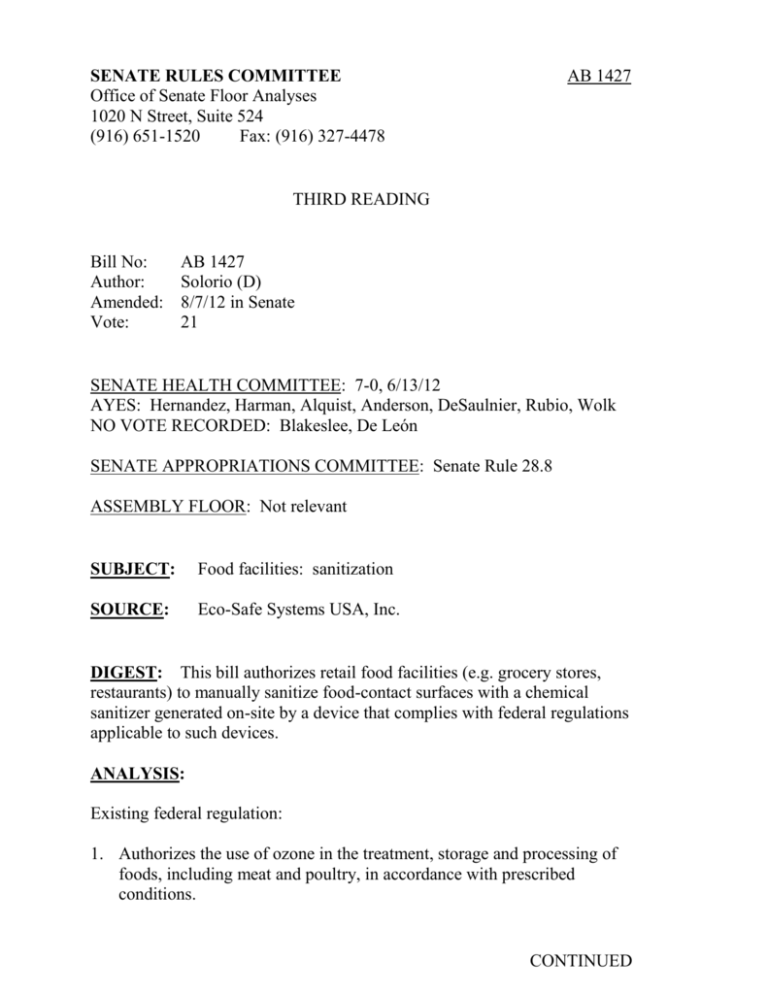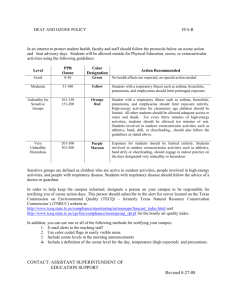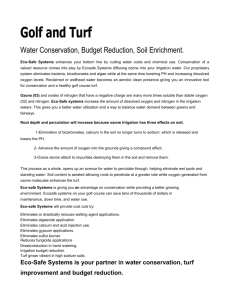Microsoft Word version
advertisement

AB 1427 SENATE RULES COMMITTEE Office of Senate Floor Analyses 1020 N Street, Suite 524 (916) 651-1520 Fax: (916) 327-4478 THIRD READING Bill No: Author: Amended: Vote: AB 1427 Solorio (D) 8/7/12 in Senate 21 SENATE HEALTH COMMITTEE: 7-0, 6/13/12 AYES: Hernandez, Harman, Alquist, Anderson, DeSaulnier, Rubio, Wolk NO VOTE RECORDED: Blakeslee, De León SENATE APPROPRIATIONS COMMITTEE: Senate Rule 28.8 ASSEMBLY FLOOR: Not relevant SUBJECT: Food facilities: sanitization SOURCE: Eco-Safe Systems USA, Inc. DIGEST: This bill authorizes retail food facilities (e.g. grocery stores, restaurants) to manually sanitize food-contact surfaces with a chemical sanitizer generated on-site by a device that complies with federal regulations applicable to such devices. ANALYSIS: Existing federal regulation: 1. Authorizes the use of ozone in the treatment, storage and processing of foods, including meat and poultry, in accordance with prescribed conditions. CONTINUED AB 1427 Page 2 2. Authorizes the use of ozone in the sanitization of water-contact surfaces in the processing and bottling of bottled water. Specifies the minimum concentration and timing of the sanitization to be .1 parts per million (ppm) ozone-water solution in an enclosed system for at least five minutes. Existing state law: 1. Provides, under the California Retail Food Code (CalCode), for the development of health and sanitation standards for retail food facilities by the Department of Public Health (DPH) and vests local health agencies with primary responsibility for enforcing these standards. 2. Requires all food facilities to provide manual methods to effectively clean and sanitize utensils and equipment at the facility, as specified. 3. Authorizes the use of chlorine, iodine, and quaternary ammonium, at specified concentrations and durations, for use in the manual sanitation of utensils and equipment during the final rinse. Additionally, authorizes manual sanitation to be accomplished by immersion in water above a specified temperature for a specified duration, or manual sanitation by other methods approved by the enforcement agency. This bill authorizes retail food facilities (e.g. grocery stores, restaurants) to manually sanitize food-contact surfaces with a chemical sanitizer generated on-site by a device that complies with federal regulations applicable to such devices. Background According to the National Small Flows Clearinghouse, ozone is an unstable gas that that can destroy bacteria and viruses. It is formed when oxygen molecules (O2) collide with oxygen atoms to produce ozone (O3). It is generated by an electrical discharge through dry air or pure oxygen. Since it is an unstable gas, it decomposes to oxygen in about 20 minutes, leaving no traces of the disinfectant. Its quick decomposition means that it must be generated onsite. Ozonation (ozone disinfection) is a common method of disinfecting wastewater and was used in a United States water treatment plant as early as 1940. According to the Economic Research Service under the U.S. Department of Agriculture (USDA), most bottled water is now treated with ozone. CONTINUED AB 1427 Page 3 For any substance commonly used in the U.S. prior to January 1, 1958, the U.S. Food and Drug Administration (FDA) allows its use in other products if an independent panel of experts deems the substance and its use as “generally recognized as safe” (GRAS). According to the USDA, ozone was deemed GRAS as a disinfectant for foods by an independent panel of experts in 1997. The GRAS determination in treating food products was an expansion of uses already approved for ozone. The FDA claims that ozone can reduce levels of harmful microorganisms, including some E. coli strains and Cryptosporidium (a common source of waterborne illness) in foods and juices, and can kill viruses and parasites. Ozone is approved as a food additive that may be safely used as an antimicrobial agent in the treatment, storage, and processing of certain foods under the conditions of use prescribed in the Code of Federal Regulations. FISCAL EFFECT: Appropriation: No Fiscal Com.: Yes Local: Yes SUPPORT: (Verified 8/7/12) Eco-Safe Systems USA, Inc. (source) ClearWater Tech DEL Industries, Inc. Simply Fresh Fruit Whole Foods Market ARGUMENTS IN SUPPORT: The bill’s sponsor, Eco-Safe Systems USA, Inc., claims that ozone is a powerful non-polluting antimicrobial sanitizer approved by the FDA and USDA to eliminate bacteria on food, including vegetables and meat. This bill allows this innovative and green technology to effectively disinfect food preparation areas and to help reduce food contamination in an ecological way. Eco-Safe claims that using ozone for disinfection is organic and free from harmful by-products and residues. Eco-Safe claims that they are an innovative and environmentally friendly company that manufactures ozonated water treatment and water reclamation systems with over 100 clients in the supermarket, restaurant, food processor, and water reclamation industries. CTW:mD 8/21/12 Senate Floor Analyses SUPPORT/OPPOSITION: SEE ABOVE **** END ****







